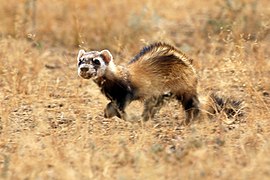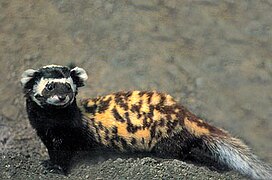Polecat

Polecat is a common name for several mustelid species in the order Carnivora and subfamilies Ictonychinae[1] and Mustelinae. Polecats do not form a single taxonomic rank (i.e. clade). The name is applied to several species with broad similarities to European polecats, such as having a dark mask-like marking across the face.
In the United States, the term polecat is sometimes applied to the black-footed ferret, a native member of the Mustelinae. In Southern United States dialect, the term polecat is sometimes used as a colloquial nickname for the skunk, which is part of the family Mephitidae.[2]
Despite their common name, polecats are related more closely to dogs than to cats.
Taxonomy
[edit]According to the most recent taxonomic scheme proposing eight subfamilies within Mustelidae, polecats are classified as:
Subfamily Ictonychinae
- Genus Ictonyx
- Striped polecat, I. striatus, (native to Central, Southern, and sub-Saharan Africa)
- Saharan striped polecat, I. libycus (Sahara)
- Genus Vormela
- Marbled polecat, V. peregusna (Southeastern Europe to western China)
Subfamily Mustelinae
- Genus Mustela
- Steppe polecat, M. eversmannii (Central and Eastern Europe, and Central Asia)
- American polecat (Black-footed ferret) M. nigripes (Southwest United States)
- European polecat, M. putorius (Western Eurasia and North Africa)
-
Striped polecat
-
Steppe polecat
-
Black-footed ferret, the “American polecat”
-
European polecat
-
Marbled polecat
See also
[edit]References
[edit]- ^ Nascimento, Fabio Oliveira do (2014). "On the correct name for some subfamilies of Mustelidae (Mammalia, Carnivora)" (PDF). Papéis Avulsos de Zoologia. 54 (21): 307–313. doi:10.1590/0031-1049.2014.54.21. ISSN 0031-1049.
- ^ "Skunk Fact Sheet" (PDF). The Georgia Department of Natural Resources Wildlife Resources Division.





